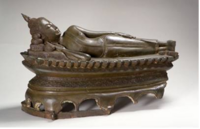Sleeping lion's posture

Sleeping lion's posture (Wyl. seng ge'i nyal stabs?) —
Sogyal Rinpoche writes:
- Traditionally the position generally recommended for dying is to lie down on the right side, taking the position of "the sleeping lion," which is the posture in which Buddha died. The left hand rests on the left thigh; the right hand is placed under the chin, closing the right nostril. The legs are stretched out and very slightly bent. On the right side of the body are certain subtle channels that encourage the "karmic wind" of delusion.[1] Lying on them in the sleeping lion's posture, and closing the right nostril, blocks these channels and facilitates a person's recognition of the luminosity when it dawns at death. It also helps the consciousness to leave the body through the aperture at the crown of the head, as all the other openings through which it could leave are blocked.[2]
Notes
- ↑ We need to bear in mind that most traditional texts [and modern ones too!] are written by males for a male readership rather than for the female. So here when it mentions the position for lying down we need to bear in mind that this is from the perspective of a male. So for men, it’s the right channel which is connected to the disturbing energies—the “karmic wind” of delusion—but for women, it’s the left channel, so women need to mirror the above position.
- ↑ The Tibetan Book of Living and Dying, page 255.
Further Reading
- Sogyal Rinpoche, The Tibetan Book of Living and Dying, pages 235, 255, 270 & 274
- Dzogchen Ponlop, Mind Beyond Death (Ithaca: Snow Lion Publications, 2006), pages 78-79.
- Tsele Natsok Rangdrol, Mirror of Mindfulness (Boston & Shaftesbury: Shambhala, 1989), page 36.